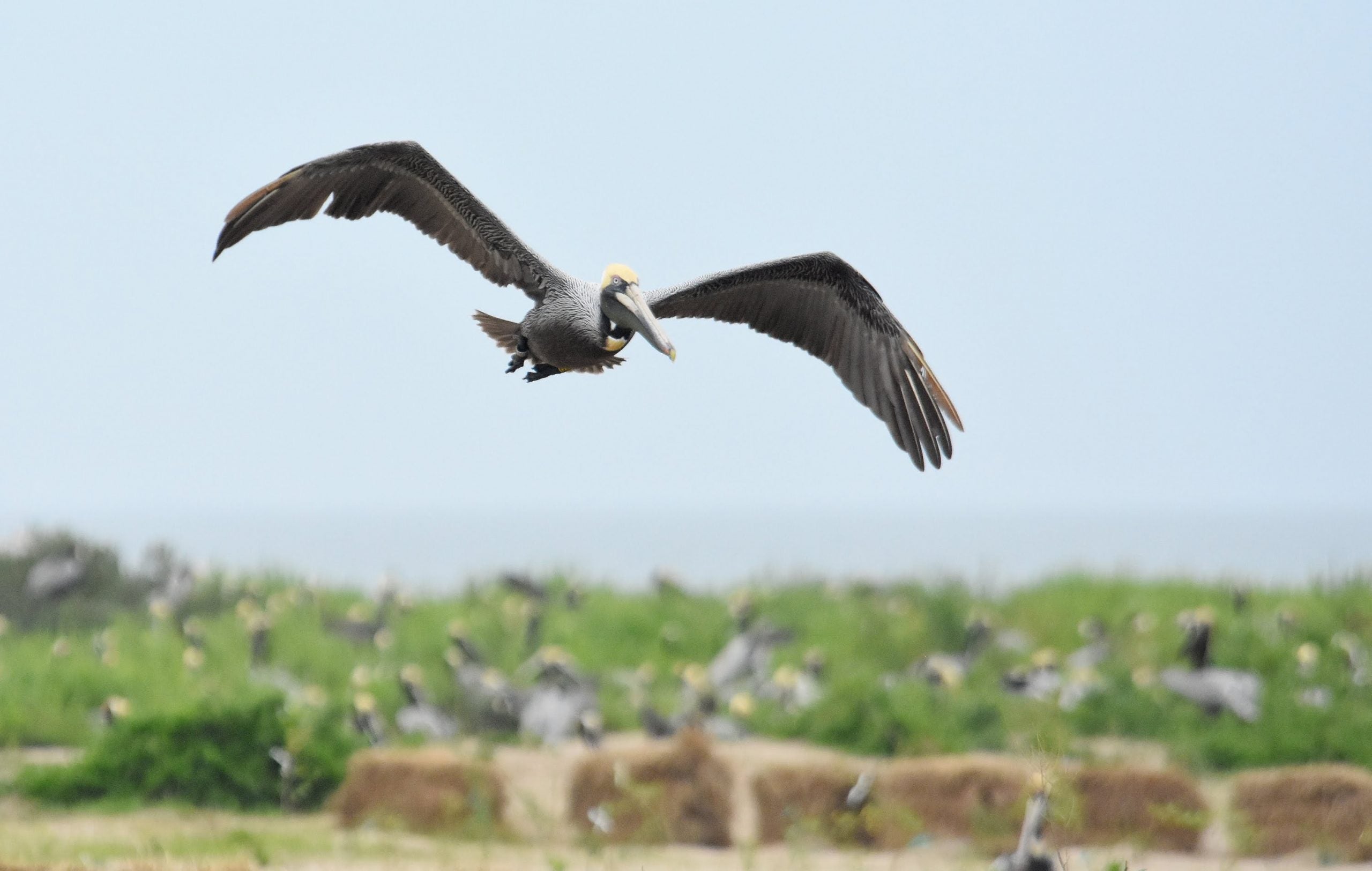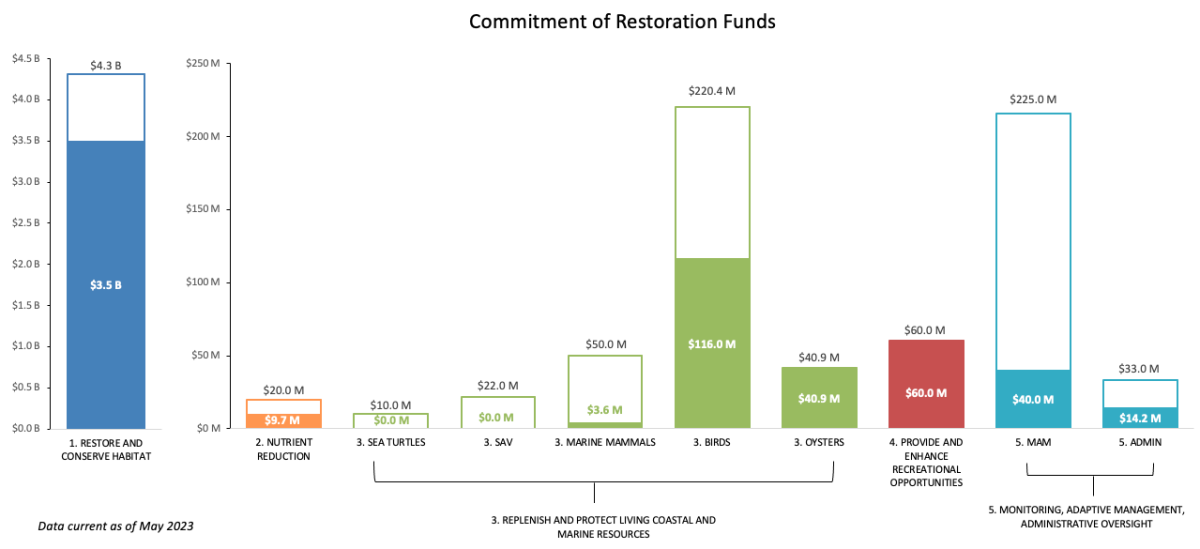When an oil spill occurs, natural resources like fish, birds, and marshes may be damaged or destroyed. A natural resource damage assessment (or “NRDA”) is a process focused on figuring out what those injuries are, coming up with a plan to repair those injuries, and then addressing them. This includes compensating the public for the lack of access to the resources while unusable (e.g., no recreational fishing or beach access). The NRDA process resulting from the Deepwater Horizon oil spill is managed by a group of federal and state representatives called ‘trustees.’
Deepwater Horizon Damage Assessment
In April 2016, a federal court approved a settlement among the United States, five Gulf states, and British Petroleum (BP) due to the April 2010 explosion that resulted in 11 deaths and the largest marine oil spill in the history of the petroleum industry. Under that settlement, BP agreed to pay up to $8.8 billion for natural resource damages pursuant to the Oil Pollution Act. Louisiana’s Trustee Implementation Group receives $5 billion to be used for ecosystem restoration through 2031. Of that, $4.3 billion will be used to restore and conserve habitat, while the remaining funds will be used to replenish and protect living coastal and marine resources ($343 million); for monitoring, adaptive management, and administration oversight ($258 million); to provide and enhance recreational opportunities ($60 million), and to restore water quality ($20 million).
 Queen Bess Island is home to a newly thriving Brown Pelican colony after completion of the Queen Bess Island Restoration NRDA project. Photo: Erik Johnson
Queen Bess Island is home to a newly thriving Brown Pelican colony after completion of the Queen Bess Island Restoration NRDA project. Photo: Erik Johnson
What is the Trustee Implementation Group?
The Louisiana Trustee Implementation Group (Louisiana TIG)—a group of federal and state representatives—currently manages the Natural Resource Restoration Program in Louisiana. When making decisions, the TIG must reach consensus, which means that both the state trustees (who must agree as a group) and the federal trustees (who must also agree as a group) must agree to the decision.
Members (State):
-
- LA Coastal Protection and Restoration Authority
- LA Oil Spill Coordinator’s Office
- LA Department of Environmental Quality
- LA Department of Wildlife and Fisheries
- LA Department of Natural Resources
Members (Federal):
-
- S. Department of Interior
- National Oceanic and Atmospheric Administration
- S. Environmental Protection Agency
- S. Department of Agriculture
How much does Louisiana get?
As of 2022, Louisiana has received $2.13 billion from BP, and $1.4 billion has been committed for projects and activities.

The chart shows the restoration funding allocated to the Louisiana Restoration Area for each restoration goal and the percentage of committed funds as of May 2023.
Approved Projects in Louisiana include:
-
- Lake Hermitage Marsh Creation
- Oyster Cultch Placement
- Oyster Hatchery
- Louisiana Outer Coast Restoration – North Breton Island
- Louisiana Outer Coast Restoration – Caillou Lake Headlands Barrier Island Restoration
- Lake Outer Coast Restoration – Chenier Ronquille
- Louisiana Outer Coast Restoration – Shell Island (East and West Lobes) Barrier Island Restoration
- Shoreline protection at Jean Lafitte National Historical Park and Preserve
- Terrebonne Basin Ridge and Marsh Creation, Bayou Terrebonne Increment
- Barataria Basin Ridge and Marsh Creation – Spanish Pass Increment
- Queen Bess Island Restoration Project
- Lake Borgne Marsh Creation – One Increment
- Rabbit Island Restoration Project
- Large Scale Marsh Creation in Barataria Bay
- Louisiana Statewide Artificial Reefs
- Pointe-aux-Chenes Wildlife Management Area – Island Road Fishing Piers
- Atchafalaya Delta Wildlife Management Area – Campground Improvements
- Middle Pearl Boat Launch
- Atchafalaya Delta Wildlife Management Area – Access Improvements
- Pass-a-Loutre Wildlife Management Area – Crevasse Access Improvements
- Pass-a-Loutre Wildlife Management Area Campground Improvements
- Pointe-aux-Chenes Wildlife Management Area Recreational Use Enhancement
- Rockefeller Wildlife Refuge Piers and Signage
- Elmer’s Island Access Project
- Bayou Segnette State Park Improvements
- Cypremort Point State Park Improvements
- Grand Isle State Park Improvements
- Terrebonne HNC Island Restoration
Learn more about restoration projects in Louisiana and other Gulf states approved by NRDA trustees here.
More information on all restoration projects here.
Members of the public can submit projects for consideration here. The TIG also seeks comments from the pubic throughout the decision making process, and you can sign up to stay up to date with that information here.
Points of Contact
-
- National Oceanographic and Atmospheric Administration, Louisiana Restoration Area Lead, Mel Landry: mel.landry@noaa.gov
- Coastal Protection and Restoration Authority, Attorney Legal Division, Christine “Chris” Barnes: chris.barnes@la.gov
- MRD Contact
- Restore the Mississippi River Delta, National Wildlife Federation, Coastal Scientist, Gulf Program, Alisha Renfro: renfroa@nwf.org